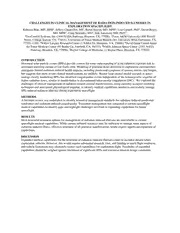
NASA Technical Reports Server (NTRS) 20170009925: Challenges in Clinical Management of Radiation-Induced Illnesses in Exploration Spaceflight PDF
Preview NASA Technical Reports Server (NTRS) 20170009925: Challenges in Clinical Management of Radiation-Induced Illnesses in Exploration Spaceflight
CHALLENGES IN CLINICAL MANAGEMENT OF RADIATION-INDUCED ILLNESSES IN EXPLORATION SPACEFLIGHT Rebecca Blue, MD, MPH1, Jeffery Chancellor, MS2, Rahul Suresh, MD, MPH3, Lisa Carnell, PhD4, David Reyes, MD, MPH3, Craig Nowadly, MD5, Erik Antonsen, MD, PhD6,7 1GeoControl Systems, Inc (2400 NASA Parkway, Houston, TX, 77058), 2Texas A&M University (400 Bizzell Street, College Station, TX, 77843); 3University of Texas Medical Branch (301 University Blvd, Galveston, TX 77555-1110); 4NASA Langley Research Center (1 NASA Dr, Hampton, VA, 23666); 5David Grant United States Air Force Medical Center (01 Bodin Cir, Fairfield, CA, 94533); 6NASA Johnson Space Center (2101 NASA Parkway, Houston, TX, 77058); 7Baylor College of Medicine, (1 Baylor Plaza, Houston, TX, 77030) INTRODUCTION Historical solar particle events (SPEs) provide context for some understanding of acute radiation exposure risk to astronauts traveling outside of low Earth orbit. Modeling of potential doses delivered to exploration crewmembers anticipates limited radiation-induced health impacts, including prodromal symptoms of nausea, emesis, and fatigue, but suggests that more severe clinical manifestations are unlikely. Recent large animal-model research in space- analogs closely mimicking SPEs has identified coagulopathic events independent of the hematopoietic sequelae of higher radiation doses, similar in manifestation to disseminated intravascular coagulation (DIC). We explored the challenges of clinical management of radiation-related clinical manifestations, using currently accepted modeling techniques and anticipated physiological sequelae, to identify medical capabilities needed to successfully manage SPE-induced radiation illnesses during exploration spaceflight. METHODS A literature review was undertaken to identify terrestrial management standards for radiation-induced prodromal syndromes and radiation-induced coagulopathy. Terrestrial management was compared to current spaceflight medical capabilities to identify gaps and highlight challenges involved in expanding capabilities for future spaceflight. RESULTS Most terrestrial treatment options for management of radiation-induced illnesses are unavailable in current spaceflight medical capabilities. While current onboard resources may be sufficient to manage some aspects of radiation-induced illness, effective treatment of all potential manifestations would require significant expansion of capabilities. DISCUSSION Expanded medical capabilities for the treatment of radiation-induced illnesses could be included aboard future exploration vehicles. However, this would require substantial research, time, and funding to reach flight readiness, and vehicle limitations may ultimately restrict such capabilities for exploration flight. Feasibility of expanded capabilities should be weighed against likelihood of significant SPEs and extensive mission design constraints.
